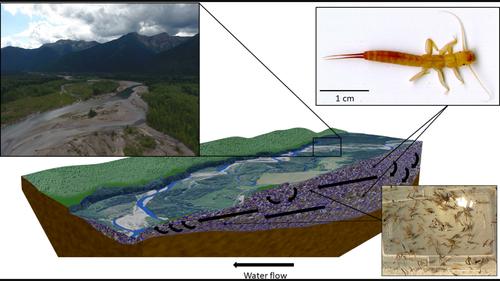Amphibitic stoneflies (Plecoptera) are integrators of ecosystem processes in alluvial aquifers of gravel-bed river floodplains
引用次数: 0
Abstract
Over 50 years ago nymphs of the Plecoptera species, Paraperla frontalis Banks, 1906 (Plecoptera: Chloroperlidae), were shown to exist in a shallow floodplain aquifer of the Tobacco River, a gravel-bed river in western Montana and later they were documented throughout the main stems of the Flathead River system. Nymphs are almost never found in surface waters, until they emerge on the river shorelines. As teneral adults, they mate and subsequently deposit fertilized eggs into the river. This novel life cycle is termed “amphibitic.” Over the years we and others have found P. wilsoni Ricker, 1965 (Plecoptera: Chloroperlidae), Kathroperla perdita Banks, 1920 (Plecoptera: Kathroperlidae), and five species of Isocapnia Banks, 1938 (Plecoptera: Capniidae), including long-winged and brachypterous adults and wingless dwarfs (male and female), occupying amphibitic niches in the alluvial aquifers of rivers in Washington, Idaho, Colorado, Alaska and British Columbia. These stoneflies are remarkably tolerant of hypoxia which allows them to exist as abundant consumers in aquifer food webs subsidized by ancient methane. Indeed, stonefly tissues contain carbon that is up to 7000 years old, underscoring the existence of a strong interaction involving the uptake of labile carbon derived from methanogenic and methanotrophic process in aquifers. Details of life cycles, trophic relationships, distribution and abundance have been documented by a suite of studies on the Nyack Floodplain of the Middle Flathead River, Montana. In this paper we review the ecophysiology and ecology of these unique stoneflies in the context of their functional role in gravel-bed river ecosystems.

两栖石蝇(褶翅目)是砾石河漫滩冲积含水层生态系统过程的整合者
50 多年前,褶翅目物种 Paraperla frontalis Banks, 1906(褶翅目:氯蝶科)的若虫被证明存在于蒙大拿州西部一条砾石河 Tobacco 河的浅洪泛蓄水层中,后来它们在整个平头河水系的主干上都被记录下来。若虫几乎从未出现在地表水中,直到它们出现在河岸上。一般成虫交配后,会将受精卵放入河中。这种新奇的生命周期被称为 "两栖"。多年来,我们和其他人发现 P.wilsoni Ricker, 1965 (Plecoptera: Chloroperlidae)、Kathroperla perdita Banks, 1920 (Plecoptera: Kathroperlidae)以及 Isocapnia Banks, 1938 (Plecoptera: Capniidae)的五个种类,包括长翅和腕足成虫以及无翅的侏儒(雄性和雌性),在华盛顿州、爱达荷州、科罗拉多州、阿拉斯加州和不列颠哥伦比亚省的河流冲积含水层中占据两栖壁龛。这些石蝇对缺氧有很强的耐受力,这使它们能够作为丰富的消费者存在于含水层食物网中,而含水层食物网则由古老的甲烷提供补贴。事实上,石蝇组织中含有的碳已有 7000 年的历史,这说明含水层中的甲烷生成过程和甲烷营养过程与吸收可变碳之间存在着强烈的相互作用。在蒙大拿州弗拉特黑德河中游的尼亚克洪泛区进行的一系列研究记录了生命周期、营养关系、分布和丰度等细节。在本文中,我们将结合这些独特石蝇在砾石河生态系统中的功能作用,对其生态生理学和生态学进行综述。
本文章由计算机程序翻译,如有差异,请以英文原文为准。
求助全文
约1分钟内获得全文
求助全文

 求助内容:
求助内容: 应助结果提醒方式:
应助结果提醒方式:


